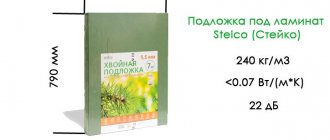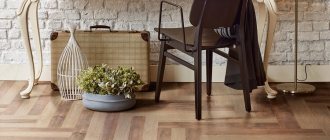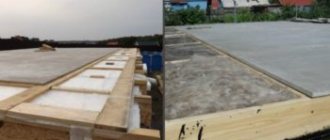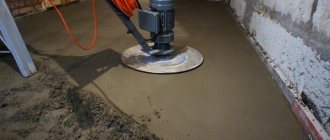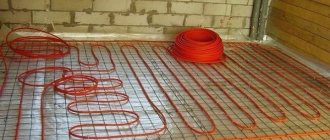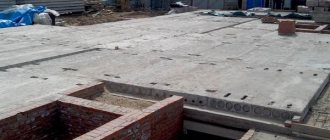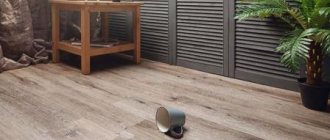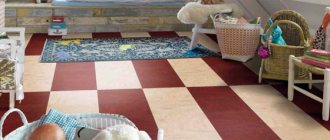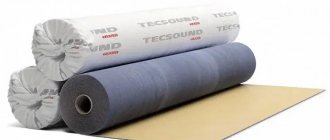Construction stores these days are replete with various materials for flooring. And, perhaps, the widest range of laminate flooring is available, the pros and cons of which will be discussed in this publication. But before you choose it, you should familiarize yourself with some of its features.
Laminate pros and cons
This coating is currently quite popular, as it is actively advertised by both manufacturers and sellers. However, to ensure the reliability of this material, it is worth listening not only to those who are interested in increasing sales. More truthful information is contained in the reviews of customers who managed to “conduct tests” in domestic conditions, laying laminate flooring in the premises of their house or apartment.
Cold laminate: causes and solutions
Cold floors are one of the most common problems that worry many residents of our country. But any, even the most unpleasant issue can be resolved if desired. And cold laminate is no exception. The main thing is to find the cause of this phenomenon and eliminate it. After all, the difficulty does not necessarily lie in the poor location of the room. You don't even imagine that your floor can become warm with small modifications.
Laminate floors
Unnatural appearance
Laminate, of course, differs for the better from linoleum. Thanks to its excellent imitation of stone, wood or other material, laminate looks very solid and attractive. However, the key word in this case is “imitation”. Upon closer inspection of the coating or with the first step taken on it, the fake becomes obvious, and the illusion disappears like smoke. Fans of solidity and natural materials are unlikely to like this nuance.
Opinions from the forums:
“At first it was unusual - they walked on the laminate floor as if they were walking on plastic. Parquet or even floorboards are much more beautiful and natural.”
“The laminate feels artificial. Barefoot you feel the unnaturalness of the coating, it does not “breathe”.
The main causes of cold flooring
- The most common cause of excessive cold in the floor area is cracks and gaps between panels. It's easy to get rid of them. For example, you can use a regular putty compound, and then mask the areas where the mixture is applied with floor paint or varnish. You can also carefully cut out the gaps a little and drive suitable sized pieces of wood into them. After sanding the surface to be repaired and covering it with paint or floor varnish, practically nothing will be visible.
- Do not forget that the floor will never be warm if its base is characterized by high humidity and dampness. To eliminate this problem, it is recommended to lay ordinary plastic film under the insulating material. But if the issue is not resolved, experts advise abandoning vents altogether and organizing underground ventilation directly in the house itself.
Laying polyethylene under insulation
- Another disadvantage may be the presence of a reduced layer of insulation material. Depending on what kind of insulation you used, look in the instructions for its use to see what thickness should be arranged.
Important! There is no need to dismantle the entire coating. To make the floor warm, you can simply remove one panel in a not too noticeable place and measure the thickness of the insulating material with a standard metal ruler.
- Also, do not forget about the cold foundation. No one is immune from this.
- Remember that the cold laminate flooring is on its own. This is because its top decorative layer has high thermal conductivity when compared with a wooden floor. What to do in this case - you ask yourself. Just lay cork material under the laminate. It will keep you warm. Or use the so-called “warm floor”.
- No matter how strange it may sound, you should never forget about the physical phenomenon of absorption of infrared radiation. Due to the fact that laminate is very thermally conductive, it allows warm rays to pass through and heats the underground. To avoid this, you can place sheets of foil under the cover.
Laying foil under laminate
- And our tactile sensations cannot go unnoticed. Experts say that flooring makes a person feel cold, although this is simply a lack of warmth. Different materials have different heat absorption characteristics from different sources. All this is ensured to update the overall balance. And that surface appears somewhat warmer if it absorbs heat more slowly.
You should not endure the constant cold of the floors. Make a little effort and turn on your imagination so that every morning begins with pleasant and warm feelings.
To get rid of the problem of cold laminate forever, you can insulate it. This is what is discussed in detail in the following video:
Instability to humidity
This problem is often encountered by buyers who prefer cheap products from unknown companies. But it also happens that high-quality coating also deteriorates from exposure to water. The fault is with the joints between the dies.
It is the joints that are the most vulnerable place of the material. Any wet cleaning inevitably leads to the seepage of drops of moisture, which allows water to easily penetrate under the coating, as a result of which the laminate swells.
The undesirable effect can be eliminated by treating the locks with water-repellent wax or oil impregnations, as well as sealant or glue.
What are the disadvantages of laminate flooring during operation?
Any building material has its drawbacks, which it is better to know about in advance. Laminate is no exception. Although it is worth recognizing that some disadvantages of laminate do exist, others are caused by improper installation, and still others are completely myths and untruths.
Possible disadvantage of laminate: harmful formaldehyde fumes
It’s worth mentioning right away that this drawback is not present in all laminate models. Typically, formaldehyde compounds are released into the air when heated.
Accordingly, those who want to install a heated floor system in a room must choose certain laminate models for the surface, without harmful components. That is, a cheap one from a little-known, or even completely unknown, brand, like most laminates from Chinese manufacturers, will not work.
Creak: a disadvantage that depends on the quality and installation of the laminate
Again, a lot depends on the conditions and quality of floor installation. If the laminate was laid on a flat surface, there should be no squeaking, or this material was initially of low quality. The opinion that sounds during laminate operation are caused by the narrow thickness of the substrate is fundamentally incorrect.
If the material used in manufacturing is of poor quality, then, despite compliance with the installation conditions, the laminate may swell and dry out over time. Therefore, you need to buy not the cheapest and only proven brands.
Instability to humidity
The joints between panels are the most vulnerable spot in a laminate surface. To ensure the stability of the joint, it is recommended to treat it with special impregnations offered by the same manufacturers of building materials.
To protect the laminate from deformation as much as possible, you should not lay it in rooms where the likelihood of water getting on the floor is very high (kitchen, bathroom). There are models of laminated surfaces that are also suitable for the kitchen or bathroom, but they are not an economical option.
It is also necessary to clean with a slightly damp cloth, in no case “sailor style”, pouring water onto the floor from a bucket and then wiping it off.
Real disadvantages of laminate: cold and loud floor
To solve the problem, a cork substrate is offered on construction bases, but it is worth noting that it comes at a high price. In everyday life, the only way to reduce unpleasant tactile sensations from a cold floor is to use a carpet.
If only low-quality material or a coating laid on a poorly prepared surface creaks, then the sound of footsteps and the sound of objects falling on the laminate is in any case very loud. A rug can partly save the situation.
Difficulty in replacing slats if damaged
To get to the defective lamella, it is necessary to disassemble the entire section of the floor down to the board to be replaced. The problem with replacing a section of laminate flooring is also that laminate collections are updated, old ones are sold out and discontinued, and new ones are already different in shade and pattern.
Therefore, finding an identical board is quite difficult. There is a technique due to which the floor after replacing the board at first glance does not raise suspicions of heterogeneity. You can replace the boards located under the furniture or closer to the wall with lamellas from the new collection, and move the original panels to visible places.
Of course, this will require additional effort and time. Minimal problems when replacing laminate panels are possible only in the case of “floating” flooring.
Fragility: a far-fetched disadvantage of laminate
It is known that laminate is classified according to wear resistance. Until recently, laminated products were divided into two categories: household (21-23 class) and commercial (31-34 resistance class).
Nowadays 21-23 class laminate is no longer produced due to its fragility. 31-32 wear resistance class is used for rooms with low and medium traffic (for example, living rooms), and 33-34 is the most durable (but also the most expensive in price), capable of withstanding high traffic (for example, a cafe).
All this points to one thing: in order for the laminate to serve the period guaranteed by the manufacturer, the operating conditions must correspond to the selected class of coating.
Conclusion
Basically, the disadvantages of laminate are found in unknown companies with low cost of products. Famous brands do not skimp on quality.
The proverb “I’m not rich enough to buy cheap things” is true.
Linoleum
Unlike the material described above, linoleum is sold in rolls of various widths and is more moisture resistant. If necessary, you can take it as wide as 3.66 mm for the entire living room or bedroom at once, so that there are no seams on the floor in the middle of the room.
Based on the material used, linoleum can be divided into:
The most expensive and environmentally friendly among them is the first option - marmoleum, which is made from jute, cork and natural oils and resins. Rubber linoleum is highly moisture resistant and has an unpleasant odor. It is more intended for industrial and specialized premises; it is better to use it for installation in residential buildings.
The nitrocellulose analogue is as flexible and durable as possible. However, it is highly flammable. The opinion of experts here is unequivocal - it is not recommended to place it in private homes. Glypthal coating is distinguished by improved sound and thermal insulation characteristics, as well as a higher price.
The most common and cheapest is PVC linoleum. It can be on a foam, fabric or felt basis and baseless. At the same time, water is strongly contraindicated for felt and fabric. If linoleum coating is used for a bathroom or kitchen, then you should choose a material with a foam backing or a thin one without a base.
Types of linoleum for flooring
Household linoleum is divided into three classes:
- “21” – for bedrooms and children’s rooms.
- “22” – for living rooms and other rooms in the house.
- “23” – for hallways and kitchens.
There are also coatings with classes “31”–“34” for offices and “41”–“43” for industrial premises, sports and medical institutions. You can take them into a residential building, but from a cost point of view this is not always justified.
What is the difference between the structure of linoleum and laminate?
How does stone laminate solve the problem of cold floors in an apartment?
If you have just moved into a new building or just want to remodel your apartment, you will definitely have to face the choice of flooring. But choosing a universal material is difficult. For example, parquet holds heat well, but is afraid of moisture. And the tiles are waterproof, but cold. Which coating should you choose? SPC laminate equally retains heat and retains moisture. The material is two-thirds stone - it is durable and easy to clean. We explain how stone laminate will make your life more comfortable.
Selection by panel connection method
Laminate parquet panels can be connected to each other in two ways - adhesive and locking. Therefore, when choosing a laminate for an apartment, you need to decide which connection method will be preferable for you.
It is easier to lay laminate using the adhesive method, but glued panels cannot be replaced if they are damaged during use.
If you buy laminate panels with a locking connection method, then, if necessary, you can easily replace a damaged panel.
Locking connection methods can be driven in (Lock) and with snap locks (Click).
The latter method of interlocking is easier to install. But, in addition, panels with click locks (Click) are less damaged.
Panels with a Click connection system with a self-leveling tongue-and-groove profile are the best solution for those who decide not to resort to the services of craftsmen and lay the laminate with their own hands.
If you choose panels with the Lock connection system, you will have to turn to the services of a specialist. Such panels must be connected to each other using a hammer and other special tools. Therefore, panels with snap locks (Click) are in great demand.
Is laminate flooring warm?
Despite the unconditional and 100% practicality of laminate, which came to the market to replace natural wood parquet, one of its disadvantages is its relative “coldness” in the room compared to the “warmth” of wooden flooring.
However, as with everything else, we tend to attribute our subjective feelings to objects, creating myths about this or that property of materials. Let's take a look at such properties as the ability to retain heat for a long time or does warm laminate exist in nature? To do this, let's turn to physics.
Thickness
Many properties of the floor covering depend on the thickness of the laminate.
The thicker the material, the more:
- soundproofing and thermal insulation qualities,
- resistance to loads,
- strength.
The optimal laminate thickness for an apartment would be 8 millimeters.
For rooms that are not used intensively, a flooring thickness of 7 mm is suitable.
It is also worth noting that a thick laminate is much more expensive than a thin coating, so it is not advisable to use it in rooms with little traffic.
The ability of a material to retain heat
The ability to retain heat is its heat capacity parameters. The higher the heat capacity, the longer the material will lose its initial temperature, despite external temperature fluctuations. Traditionally, heat-intensive building materials include almost all of their known representatives: brick, concrete, polystyrene, mineral wool, wood, gypsum and even glass. However, one must take into account the fact that the immediate value that will influence a person’s subjective sensations will be the thickness of the layer used: the thicker it is, the longer the process of heat loss occurs. When choosing a floor for a home, the consumer cannot always influence the thickness, since we often choose serial products.
Replacement doesn't always help
Laminate (especially classes 32 and above) has a fairly reliable and durable protective layer that is resistant to mechanical stress. For a long time, he doesn’t care about ladies’ heels, dog’s claws, children’s races in toy cars and other destructive factors. However, gradually this layer wears out. Alas, it is impossible to polish the material in a new way - it belongs to the category of “disposable”. You can replace panels that have become unusable or have lost their appearance, but using this technology is not always possible or advisable (for example, due to the lack of laminate of the appropriate color on sale). In such cases, owners most often completely change the entire coating.
Opinions from the forums:
“Parquet is easier to repair - sanded and varnished, but laminate needs to be changed...”
“Our neighbors poured laminate flooring. Theoretically, it was necessary to replace no more than 1/3 of the floor area. We bought the same number as it was, but it didn’t match the shade. I had to change everything."
Low moisture resistance
This is perhaps the most significant flaw of cheap laminate. In a residential apartment, liquid always spills on the floor: tea, beer, water for watering plants are spilled, the rag is difficult to wring out when washing the surface, etc. Pets can be sources of unwanted moisture on laminate flooring. If the protective coating is largely capable of protecting the front edge of the laminated board from moisture, then the joints are truly the “Achilles heel” of this material. Water getting between the panels can lead to deformation (swelling), cracking and destruction.
Opinions from the forums:
“The laminate was flooded with water - the neighbors flooded. In some places you can already see swelling at the seams.”
“Laminate is not at all friendly with moisture. A friend’s puppy made puddles in the hallway a couple of times, causing the laminate to swell. I had to change it."
Photo: budmaydan.com
Installation pitfalls
Each package of laminate flooring is equipped with instructions that allow even a person uninitiated in repair and construction secrets to carry out installation independently. Moreover, in case of an error, it is possible to disassemble the unsuccessful design and start over. However, this seemingly simple procedure is fraught with a requirement, the violation of which can lead to undesirable consequences - from loss of the right to warranty service to undesirable phenomena during operation (creaks, crackles, damage to locks). The surface of the base on which the laminate is laid must be dry and perfectly flat. Only a height difference of up to 3 mm per square meter is allowed. It is clear that in the case of laying laminate flooring on a wooden floor or on a sloppy concrete screed, it is quite difficult to fulfill this condition. Another consequence of violating the installation rules may be swelling (“bubbling”) of the assembled structure, which will also lead to failure over time.
Opinions from the forums:
“Apparently, the floor was not leveled well, and in some places the locks at the joints of the slabs simply broke.”
“I installed laminate flooring through a company. First they made the screed, and then laid it. Over time, I noticed that the floor was creaking in one place. I didn’t follow it right away. I don’t even know what to do - the money has already been paid.”
Acoustic discomfort
This is another drawback that linoleum and often wooden floors almost always lack. Laminate, even laid on a standard substrate, has a peculiar “drum effect” - it makes a booming sound when walking in hard shoes or heels. Also, when laid on an uneven or unprepared surface, laminate slabs can often make an annoying squeaking sound when walked on. Using cork material 2-4 mm thick as a base partially helps to avoid such problems. At least protect the residents of neighboring apartments from them. But the price also increases significantly.
Opinions from the forums:
“The neighbors living upstairs have laminate flooring. Their movements in soft slippers cause such a roar that they just turn out the lights. And if someone, God forbid, runs or drops something, they can hear it three floors below.”
“We have inexpensive laminate flooring in our office space. It’s simply impossible to walk on it, especially in heels – it feels like a herd of horses is galloping.”
